Has a tyre pressure warning light appeared on your dashboard? The yellow symbol looks like the cross-section of a tyre with an exclamation mark inside. But what does the warning light mean, and what should you do about it?

What is the tyre pressure warning light?
The warning light is an alert message to the driver that there may be a loss of air pressure from one or more of the vehicle’s tyres. It comes from the Tyre Pressure Monitoring System (TPMS), an active safety technology that has become a legal requirement for all newly launched and factory updated passenger cars sold in Europe since November 2014.
Tyres represent the only contact your vehicle has with the ground, so maintaining the correct tyre pressure has many safety and efficiency benefits. These include:
- Prevents accidents caused by a critical decrease in tyre pressure
- Helps the vehicle perform predictably
- Saves fuel
- Reduces emissions
- Optimises tyre wear
How does a Tyre Pressure Monitoring System work?
There are two types of TPMS: direct and indirect. Direct systems are installed in the majority of Toyota’s current passenger car line-up, and this method uses a battery-powered sensor integrated into the valve assembly (see images below) to physically measure air pressure from within the tyre cavity itself.
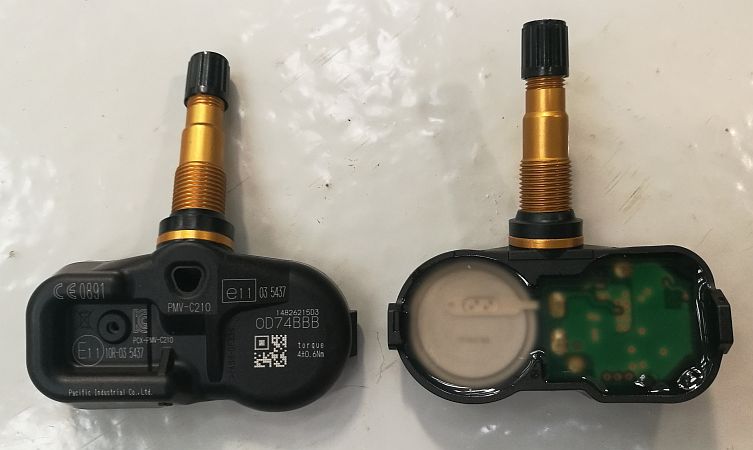
Data from the sensor in each wheel is transmitted wirelessly to a control module connected to the car’s central computer, which prompts a visible alert for the driver if any of the tyres lose pressure. The control module is programmed with the unique serial numbers of the valves within the car’s system. This ensures that the TPMS assembly in each wheel only communicates with its host control module.

The only exception within Toyota’s passenger car line-up is the Proace Verso MPV. This model is equipped with an indirect system, which uses the existing wheel speed sensors within the anti-lock braking system to ‘measure’ tyre pressure by detecting differences in the rate of wheel rotation. A tyre with less air pressure will have a smaller circumference and therefore spin at a faster rate than a wheel that has not lost air pressure.
Data from the wheel speed sensors is communicated directly to the ABS control unit, which prompts a visible alert for the driver if any wheel speed abnormalities are detected.
What should I do if the tyre pressure warning light comes on?
If the tyre pressure warning light comes on, the air pressure in at least one of your tyres will have dropped below a minimum tolerance level – often a deflation of around 20-25%. This may indicate a leak, puncture, or some other kind of damage.
Dramatic changes in ambient temperature, such as driving from a snow-capped mountain to a warm and sheltered valley, can occasionally cause direct systems to prompt an alert until the temperature has stabilised. Similarly, indirect systems can occasionally mistake uneven tyre wear for a fluctuation in tyre pressure.
Irrespective of the circumstances, if the TPMS warning light comes on you should pull into a safe area and visually check the tyres. If any appear to be deflated yet undamaged you should try to re-inflate them to the correct pressure and reset the TPMS (see subheading below).
If the tyre has sustained more serious damage, it will be necessary to either continue your journey on the spare wheel, carry out a temporary repair using a tyre repair kit, or call an emergency breakdown service for a lift to a tyre centre.
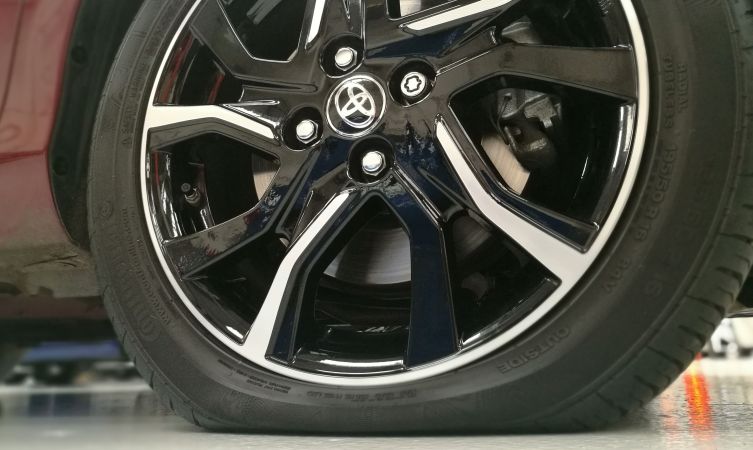
How do I turn off the tyre pressure warning light?
Use the box below to identify the type of TPMS fitted to your car (only current models are listed below). You will also need to know whether the reset function is accessed via a button or sub-menu within the main display.
Once you have accessed the right sub-menu, instructions for resetting the TPMS will be shown within the main display. For those with a physical button, you simply need to turn the ignition on, then press and hold the TPMS button. The warning light will flash a couple of times and then extinguish, at which point the system has been reset.
| MODEL | TPMS TYPE | RESET ACCESS | LOCATION |
| Aygo X | Direct | Software menu | Vehicle Settings menu on Multi-info Display |
| Yaris | Direct | Software menu | Vehicle Settings menu on Multi-info Display |
| Yaris Cross | Direct | Software menu | Vehicle Settings menu on Multi-info Display |
| Corolla | Direct | Software menu | Vehicle Settings menu on Multi-info Display |
| Toyota C-HR | Direct | Software menu | Vehicle Settings menu on Multi-info Display |
| bZ4X | Direct | Software menu | Vehicle Settings menu on Multi-info Display |
| RAV4 | Direct | Software menu | Vehicle Settings menu on Multi-info Display |
| RAV4 Plug-in | Direct | Software menu | Vehicle Settings menu on Multi-info Display |
| GR86 | Direct | Button | Lower dashboard on passenger’s side |
| GR Supra | Direct | Software menu | Vehicle Status menu on Supra Command |
| Land Cruiser | Direct | Button | Under dashboard on driver’s side |
| Highlander | Direct | Software menu | Vehicle Settings menu on Multi-info Display |
| Proace Verso | Indirect | Software menu | Driving Functions menu on Pro-Touch display |
| Mirai | Direct | Software menu | Vehicle Settings menu on Multi-info Display |
What should happen if I replace any tyres?
Direct: The condition and function of the TPMS valve and sensor assembly should be checked each time the tyres are replaced. This will involve a physical inspection and electronic diagnosis using a proprietary technology (example device in image below).
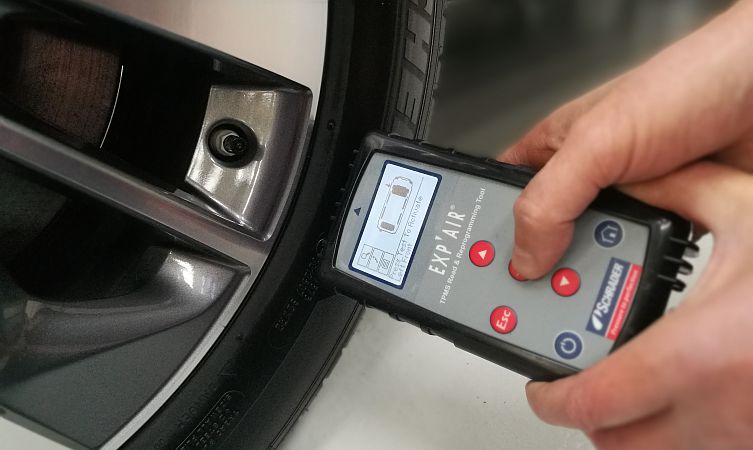
The integrated battery has a life expectancy of around ten years and cannot be replaced. Electronic diagnosis should reveal the health of the battery, which will help you decide whether to replace the entire unit at the same time as the tyre.
Although the main valve assembly is robust, parts exposed to the atmosphere can deteriorate over time. So if the battery level is adequate and the main unit is being retained, it would still be wise to have the grommets, washers, collars and cores (see image below) replaced as a matter of course.

Indirect: As this system is not directly related to the tyres, no further measures are needed, assuming the tyres are being replaced on a like-for-like basis. However, it is always wise to replace the valves when changing tyres.
Will changing the wheels affect the TPMS?
Not if your car features indirect TPMS measuring. In which case, you can switch to and from winter tyres with no additional system programming.
Due to the accuracy and complexity of direct measuring, the TPMS control module is designed to recognise and communicate with only one set of wheels at a time. So if you regularly switch to and from winter wheels it will be necessary for a qualified technician to reprogramme the control module through the vehicle’s OBD port.
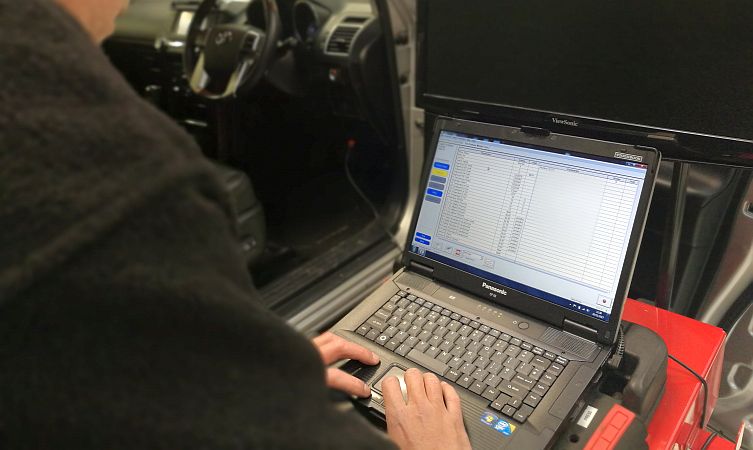
There are occasions when it may be necessary to drive on a wheel that is not equipped with a TPMS valve, such as after a puncture when the spare wheel is fitted. Under such circumstances, the warning light will remain illuminated. The vehicle or tyre monitoring system will not be damaged but the vehicle cannot pass its annual MoT test if the warning light is on.
Do I still have to check my tyres manually?
Although TPMS is designed to deliver a safety alert in the event of a significant loss of tyre pressure, it does not replace manual inspections. Each tyre should be regularly checked to see if it is inflated to the correct air pressure and has sufficient tread depth.




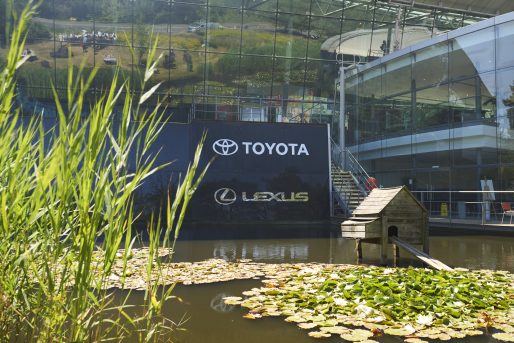

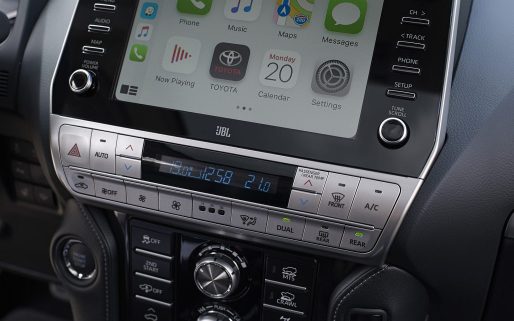
My wife has a toyota yaris hybrid 2018 , I have purchased ànother set of geniune alloy wheels which have tpms valves fitted, can I programme these into her yaris tpms ecu so she can have two sets of tpms valves programmed in the ecu for switching between winter and summer.
Hi Ian,
Please contact your nearest Toyota Centre for further advice on this.
You can find them using this link – https://fal.cn/3h2dT
Thanks.
Very nice and informative 👍
I have two Toyota Auris in my family. A few months ago, my daughter’s Auris had a puncture but she had an urgent need of the car. So I put a wheel from my car on her’s.
I then took the wheel to a service station, got it repaired and put it on my car.
So both our cars now have a wheel that is not originally from that car.
The reason I am writing is that I do not remember which wheel I replaced.
The tyre pressure light is on in both vehicles. Whereas the pressure in the tyres are correct.
What can I do now? I tried to recalibrate but that is not working.
Hi Khurshid,
Thanks for your comment.
Your Toyota Centre would be best placed to advise on this as they can physically inspect your vehicle.
Thanks.
Hi
is this the right product number for my Rav4 reg GF14UWJ ?
Genuine Toyota Rav4 Tyre Pressure Sensor TPMS Valve 42607-60010
Hi Mariyan,
This part number shows ‘VALVE SUB-ASSY, TIRE PRESSURE MONIT’. Therefore, this should be correct.
Your Toyota Centre would be best placed to advise if this is suitable for your RAV4.
Please let us know if you have any further questions.
Hi,
My 2013 RAV4 Invincible has a tiny air leak from the base of the valve on one of the wheels. It causes the TPMS light to come on about every 10 days. My question is, are the sealing washers available separately to repair the leak or is it a complete sensor assembly replacement (which would be unnecessarily expensive I’m sure you’d agree)?
Thanks.
Hi Richie,
We would recommend taking your RAV4 to your nearest Toyota Centre.
They can physically inspect your vehicle and provide any necessary recommendations or repairs.
Thanks.
My Toyota Yaris Cross, New Sept. 2021 Model. The Tyre Pressure Warning light comes on in cold weather and does not go off unless the weather warms up. My dealer tells me this is normal and the tyres will not bo warm enough to cancel this until over 20 mile have been driven. Surely this cannot be correct, my tyre pressures are correct.
Hi Terry,
Thanks for your comment and congratulations on your new Yaris Cross.
Temperature can slightly affect the pressure of a tyre.
However, the pressures of your tyres are set (at cold) by your Toyota Centre and then the system checked for any issues.
Thanks.
How can I use the compressor that came with the tire repair kit in my Prius (2018) to adjust tire pressure (not to repair)? Is there a how to video somewhere you can point me to? Thanks!
Hi,
We would recommend referencing your owners manual for advice on the Emergency Tyre Repair Kit.
This is not to be used to check or adjust tyre pressures.
The Gel/fluid used during a tyre repair is an integral part of the inflation process.
We would advise using another Compressor to inflate the tyres.
Thanks.
I have a June 2020 Prius+. Tyre pressure warning light is alternating between on and off. Tyre pressure is fine. I can’t find the TPMS reset button to reset the system. It is supposed to be under the dashboard at the driver side but I can’t find it.
Hi Lilian,
Thanks for your comment.
We would recommend referring to your User Manual for information on the reset button.
However, may we ask how often the warning light is altering between on and off?
Thanks.
A couple of days ago I had a tyre replaced on my Aygo by a Toyota garage during my service and MOT. This morning, in cold temperature, after driving a couple of miles, the tyre pressure light came on. I haven’t had a chance to check the pressure yet (and I’m assuming after a service they’ll all be fine) but does this regularly happen when new tyres are installed?
Hi Dave,
Naturally, tyre pressure will drop a little (around 0.2psi per degree) in colder temperatures without your tyres actually losing any air!
This may cause the tyre pressure light to come on, but there is no harm in checking.
Please let us know if you have any further questions.
Thanks.
I have steel winter wheels on my 2017 Avensis estate, so the warning light is permanently on. I have also just had a crack appear in my windscreen which requires replacement, but Autoglass will not do it because of a “fault” in the cruise control system ( which is working fine). Is this due to the wheel light?
Hi Gary,
We would recommend taking your vehicle to your Toyota Centre.
They will be able to physically inspect it and diagnose any potential issues.
Thanks.
My car is alphard 2015 model GGH30 from Japan. It shows the Tire Pressure warning. In the tires there is no sensor at all.
1. Should I buy which model of sensor to install ?
2. How to get ride of the warning ?
Hi Sotheayuth,
Thanks for your comment.
We would recommend contacting your Toyota Centre for further assistance.
Thanks.